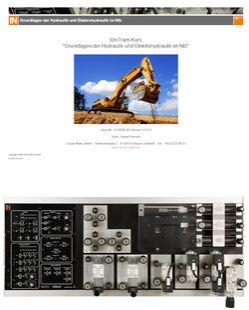Course: Fundamentals of hydraulics and electro-hydraulics

Due to the increasing complexity of modern commercial vehicles, the demands placed on the hydraulics used in such vehicles are also becoming ever greater. The growing requirements expected of systems for both comfort and safety have, along with improvements in energy efficiency, brought about rapid development of hydraulic applications. Such modern systems, which are constantly evolving, are nowadays tightly integrated with open and closed-loop control systems.
The multitude of functions arising from this requires servicing mechanics to have a well-grounded and extensive knowledge of hydraulics and its many applications. This is why Lucas-Nülle have developed a training system which allows for learning techniques which are as close as possible to those used in practice, as well as conveying the necessary fundamentals in simple and understandable fashion. The course imparts fundamental knowledge of hydraulics. By means of many tried and tested experiments, it illustrates the function and workings of hydraulic control systems in a clear and comprehensible manner.
Experiment hardware:
The board for the course consists of the following components:
- 2x Double-acting cylinders with displacement sensors and end-limit initiators
- 2x One-way restrictor valves
- 1x Mechanically operated 4/3-way directional valve
- 1x Mechanically operated 4/2-way directional valve
- 1x Electrically operated 4/2-way directional valve
- 1x Electrically operated 4/3-way directional valve
- 1x Electrically operated 2/2-way directional valve
- 3x Pressure sensors
- 2x Pressure monitors
- 1x Time-delay relay, adjustable with delayed pull-on
- 1x Time-delay relay, adjustable with delayed pull-off
- 2x Displacement sensors for double-acting cylinders
- Relays, operating controls and viewing elements for construction of hard-wired control systems
- Virtual relays, operating controls and viewing elements for construction of programmable controls in the course software
- Built-in microcontroller for measurement and control purposes
Training contents:
Thanks to the synergy between the training system and the Labsoft course, the following training contents and understanding of the systems can be conveyed:
- Fundamentals of hydraulics/electro-hydraulics with reference to practical applied cases in commercial vehicles
- Hydraulic and electrical circuit diagrams
- Single- and double-acting cylinders
- Extending cylinders with the help of hand-lever valves
- Extending cylinders with the help of buttons and electrically operated directional valves
- Measuring the effect of system pressures on cylinders
- Normally closed limit switches
- Parallel operation of two cylinders by means of two directional valves (mechanical and electrical)
- Operation of two cylinders by means of one directional valve (mechanical and electrical)
- Pressure-dependent control
- Creating closed-loop control circuits with the help of pressure sensors
- Introduction to reading electrical and hydraulic circuit diagrams and creating your own
- Programming electrical circuit diagrams with the help of the circuit diagram editor
- Measurement of pressure via pressure gauge in Labsoft
- Tracing cylinder movements and associated pressures in Labsoft
- Recording of displacement-time diagrams
- Diagnosing functional breakdowns in hydraulic systems and rectifying them
- Learning about faults which commonly occur in practice and their causes by means of sample experiments
- Course duration: 16 h approx.